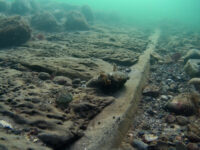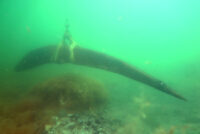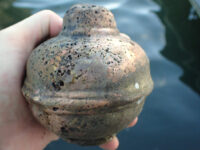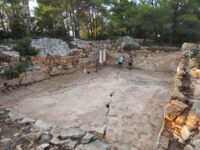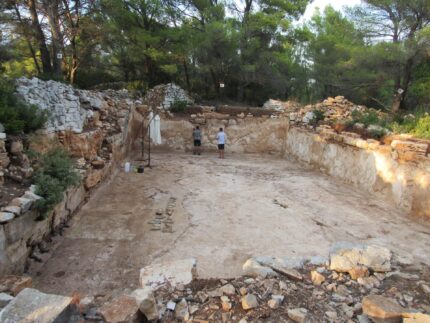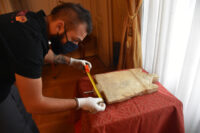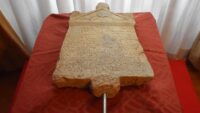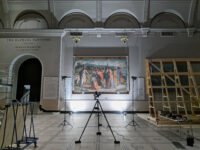 The Raphael Court, the V&A gallery dedicated to the seven surviving tapestry cartoons created by Raphael, will reopen in November after a nine-month refurbishment. They’re getting in right under the wire to commemorate the 500th anniversary of Raphael’s death (April 6th, 1520). The upgraded Raphael Court features acoustic paneling, new furniture for more comfortable contemplation of the masterpieces and new LED lighting that reduces glare on the glass and massively improves their visibility.
The Raphael Court, the V&A gallery dedicated to the seven surviving tapestry cartoons created by Raphael, will reopen in November after a nine-month refurbishment. They’re getting in right under the wire to commemorate the 500th anniversary of Raphael’s death (April 6th, 1520). The upgraded Raphael Court features acoustic paneling, new furniture for more comfortable contemplation of the masterpieces and new LED lighting that reduces glare on the glass and massively improves their visibility.
 The cartoons depicting scenes from the lives of Saints Peter and Paul were commissioned by Pope Leo X in 1513. He wanted monumental tapestries to decorate the lower walls of the Sistine Chapel, but to be worthy of the glorious frescoes by Michelangelo on the ceiling and wall behind the altar, the tapestries had to be designed by the greatest artist of the era instead of the staff designers in the workshop of Flemish weaver Pieter van Aelst. Raphael produced 10 elaborate cartoons the full size of the tapestries: 10 feet high and between 10 and 16 feet wide. The designs were rich in character, landscape and architectural detail and Raphael painted them with the same complex palette he used in all his works.
The cartoons depicting scenes from the lives of Saints Peter and Paul were commissioned by Pope Leo X in 1513. He wanted monumental tapestries to decorate the lower walls of the Sistine Chapel, but to be worthy of the glorious frescoes by Michelangelo on the ceiling and wall behind the altar, the tapestries had to be designed by the greatest artist of the era instead of the staff designers in the workshop of Flemish weaver Pieter van Aelst. Raphael produced 10 elaborate cartoons the full size of the tapestries: 10 feet high and between 10 and 16 feet wide. The designs were rich in character, landscape and architectural detail and Raphael painted them with the same complex palette he used in all his works.
 Tapestry cartoons were ephemera, used as weaving templates until they wore out. They were not considered artworks worthy of preservation, and even Raphael’s were only kept because van Aelst used them to make copies of the tapestries for other clients. By the early 1600s, only seven were left. They were acquired by the then-Prince of Wales (future Charles I) for £300, and managed to survive the Civil War, the Cromwellian Commonwealth and the Restoration. In 1865, Queen Victoria lent them to the South Kensington Museum in memory of her late lamented husband. That museum is now named after her and said husband.
Tapestry cartoons were ephemera, used as weaving templates until they wore out. They were not considered artworks worthy of preservation, and even Raphael’s were only kept because van Aelst used them to make copies of the tapestries for other clients. By the early 1600s, only seven were left. They were acquired by the then-Prince of Wales (future Charles I) for £300, and managed to survive the Civil War, the Cromwellian Commonwealth and the Restoration. In 1865, Queen Victoria lent them to the South Kensington Museum in memory of her late lamented husband. That museum is now named after her and said husband.
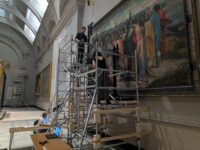 In order to display them in a space suited to their original context, the V&A built the Raphael Court in almost identical proportion to the Sistine Chapel. The gallery was last refurbished in the early 90s.
In order to display them in a space suited to their original context, the V&A built the Raphael Court in almost identical proportion to the Sistine Chapel. The gallery was last refurbished in the early 90s.
The work on the infrastructure took place with the cartoons in situ as they are far too fragile to get moved around (as are the tapestries they were used to create, now in the collection of the Vatican but almost never displayed). Researchers were able to take advantage of the nine months to unframe the  works, scan their surfaces in high-resolution 3D, use infrared imagining and composite photography to enhance our understanding of this unique group of monumental works by one of the greatest artists of the Renaissance. The 3D scans are of special interest with the cartoons because they were punctured in order to transfer the image in the tapestry, giving them a unique texture compared to other drawings and paintings.
works, scan their surfaces in high-resolution 3D, use infrared imagining and composite photography to enhance our understanding of this unique group of monumental works by one of the greatest artists of the Renaissance. The 3D scans are of special interest with the cartoons because they were punctured in order to transfer the image in the tapestry, giving them a unique texture compared to other drawings and paintings.
 All of this new data will be invaluable to researchers and conservators in the study and care of the cartoons. They are also being used to create new interactive features for visitors to the museum to access via QR codes or directly from the V&A’s website.
All of this new data will be invaluable to researchers and conservators in the study and care of the cartoons. They are also being used to create new interactive features for visitors to the museum to access via QR codes or directly from the V&A’s website.
Imagery and a suite of new interactive interpretation will be available online, accessed in the gallery via QR codes, allowing visitors to engage with the interpretation on site using their own devices. Visitors will be able to zoom in and discover the design and making of the Cartoons and Raphael’s extraordinary creative process through detailed imagery and interactive features that highlight the significance and status of the Cartoons in multiple ways. Stories told will include the Cartoons’ function as full-scale tapestry designs for the Sistine Chapel, the ingenuity of Raphael and his workshop and their design process, the rescue, life and status of the Cartoons in England from their arrival in the 17th century, and the fascination they have provoked since then up to the present day. A new publication, edited by Dr Ana Debenedetti, will further contextualise the creation and afterlife of the Cartoons, shedding light on Raphael’s artistic practice and the organisation of his large workshop, the fate of the tapestries made for the Sistine Chapel, and the rediscovery and reception of the Cartoons, especially in Britain.
Dr Ana Debenedetti, Lead Curator of the Raphael Project and Curator of Paintings at the V&A said:
“The set of seven surviving tapestry Cartoons by Raphael comprise a unique Renaissance treasure, both in terms of aesthetic value and technical achievement. Cutting-edge technology, provided by Factum Foundation, offered non-invasive methods of studying such canonical works of art by allowing us to look beneath the visible layers of paint and discover Raphael’s creative process. It is a feast for the eye to be able to enjoy the extraordinary beauty of these monumental drawings which are over 500 years old. We look forward to sharing this enhanced experience with our visitors when the gallery reopens in November to mark Raphael’s 500th anniversary.”

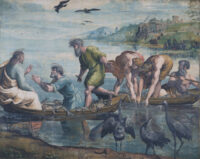



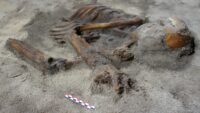 Archaeologists have unearthed a skeleton from the Merovingian era buried on Gimsøya, one of the islands in the Lofoten archipelago of northwestern Norway. An Iron Age farm was known to have active in the area, so when a new campsite was planned near the town of Hov, archaeologists surveyed the site before construction to salvage any cultural heritage materials.
Archaeologists have unearthed a skeleton from the Merovingian era buried on Gimsøya, one of the islands in the Lofoten archipelago of northwestern Norway. An Iron Age farm was known to have active in the area, so when a new campsite was planned near the town of Hov, archaeologists surveyed the site before construction to salvage any cultural heritage materials.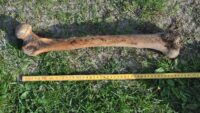 The bones have not been radiocarbon dated yet and the axe can’t be dates, so there were no grave goods that might provide a possible date range. Based on the age of charcoal samples recovered in an associated cultivation layer near the skeleton, archaeologists estimate the burial dates to the Merovingian era, the 8th or 9th century.
The bones have not been radiocarbon dated yet and the axe can’t be dates, so there were no grave goods that might provide a possible date range. Based on the age of charcoal samples recovered in an associated cultivation layer near the skeleton, archaeologists estimate the burial dates to the Merovingian era, the 8th or 9th century.